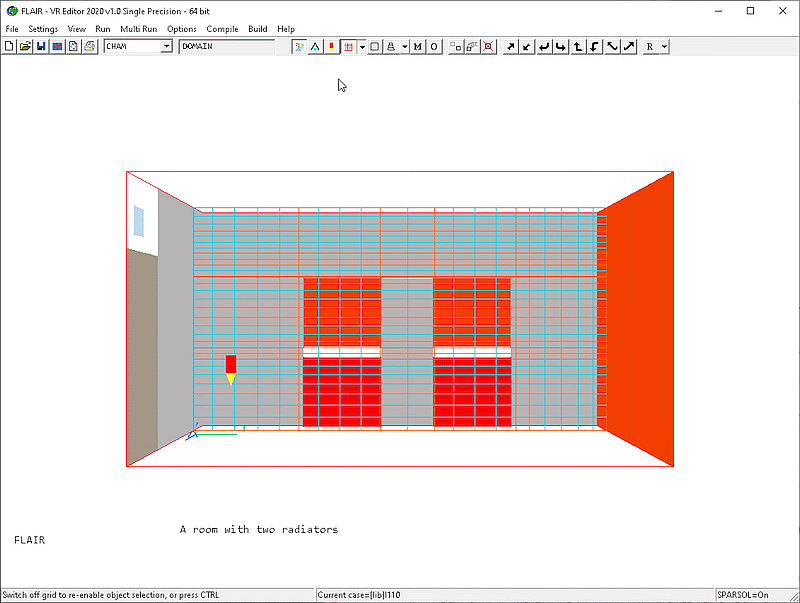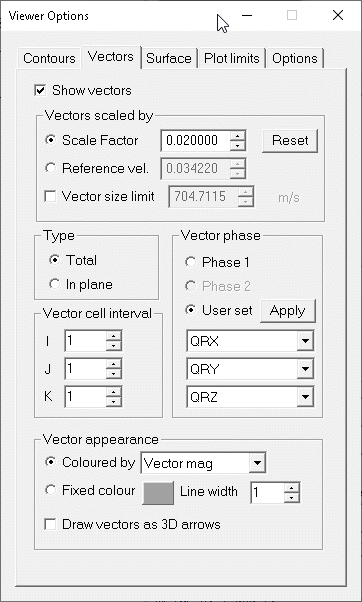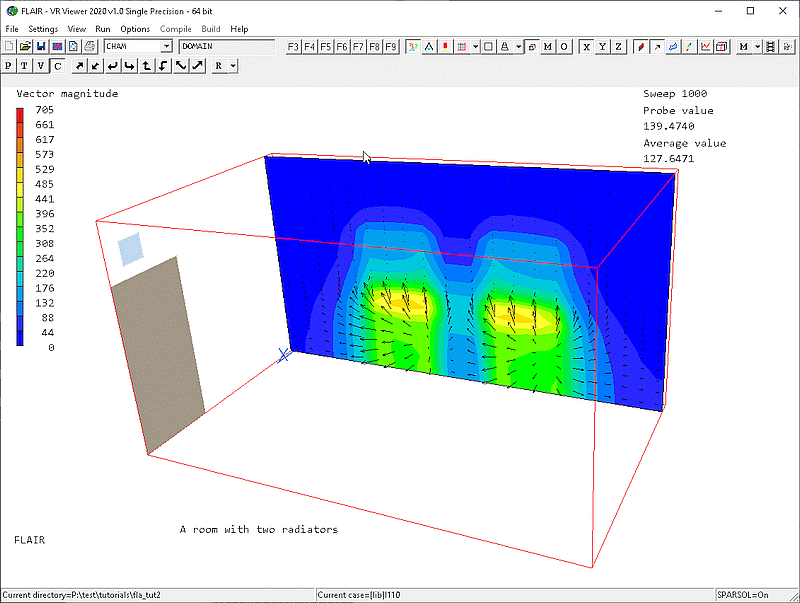FLAIR Tutorial 2: A room with two radiators
This case models a three-dimensional room, consisting of two closed windows, a door.
The radiators underneath each window produce a heat flux of 500W each and the walls are
fixed at 20 degree C. The IMMERSOL model is used. The 'Duplicate object' function is used
for the creation of the second window and radiator. The material of the radiators is
selected from the property database.
The following picture shows the geometry.

Setting up the model
Start FLAIR with the default room
- Click FLAIR icon (a desktop shortcut created by the FLAIR installation program); or
- Start the VR-Editor by clicking on 'Start', 'Programs', 'FLAIR', then 'FLAIR-VR'.
- Click on the 'File' button and then select 'Start new case', followed by 'FLAIR' and
'OK'.
The FLAIR VR-Environment screen should appear, which shows the default room with the
dimensions 10mx10mx3m.
Resizing the room
- Change the size to 3m in x-direction, 5m in y-direction and 2.7m in z-direction
respectively on the control panel. Alternatively, the user may click on the main 'Menu'
and then bring up the 'Geometry' panel to change the room size.
- Click on "Reset" button,
 on the movement panel, and then click on "Fit to window"
and 'OK'.
on the movement panel, and then click on "Fit to window"
and 'OK'.
To activate the physical models
a. The Main Menu panel
- Click on the main 'Menu' button. The top page of the main menu will appear on the
screen.
- Click on the 'Title' dialogue box. Then type in 'A room with two radiators'.
- Click on 'Models' to obtain the Model menu page.
FLAIR always solves pressure and velocities. The temperature is also solved as the
default setting.

The 'Models' page of the Main Menu.
b. To activate LVEL turbulence model
- Click on the 'Turbulence models' button to bring up a list of available turbulence
models. Select the 'LVEL' from it.
- Click on 'OK'.
c. To activate IMMERSOL radiation model
- Click on 'Radiation models' button. The following dialog box will appear

- Select 'Immersol' and click 'OK' to activate the IMMERSOL model
- Click on the 'settings' button next to the text 'IMMERSOL', and set storage of the
radiative heat fluxes QRX, QRY, QRZ to 'On'. They can later be used to indicate the
radiative heat transfer.
- Click on "Top menu" back to the top menu panel, then OK to close the Main Menu
Adding objects to the room
a. add a door
- Click on the 'Object' menu and select 'New' (New Object), 'Plate' and select Y plane on the 'Object management'
dialog box to bring up the 'Object specification' dialog box
- Change name to 'DOOR'.
- Click on the 'Size' button and set 'Size' of the object as:
X: 1.0 m
Y: 0.0 m
Z: 2.0 m
- Click on the 'Place' button and set 'Position' of the object as:
X: tick 'at end'
Y: 0.0 m
Z: 0.0 m
- Click on 'General' button and 'Attributes', and leave the default setting 'Adiabatic'
- Click on 'OK' to return to the 'Object specification' dialog box. Click on 'OK' again.
b. add the first window
- Click on the 'Object' menu and select 'New' (New Object), Plate' and select X plane on the 'Object management'
dialog box to bring up the 'Object specification' dialog box
- Change name to 'WIND1'.
- Click on the 'Size' button and set 'Size' of the object as:
X:0.00 m
Y:0.98 m
Z:0.87 m
- Click on the 'Place' button and set 'Position' of the object as:
X: 0.0 m
Y: 1.28 m
Z: 1.0 m
- Click on 'General' button 'Attributes', and then set the 'Energy source' to 'Surface temperature' and
value to 15 degree C.
- Click on 'OK' to return to the 'Object specification' dialog box. Click on 'OK' again to
exit from the 'Object specification' dialog.
c. add the second window by duplicating the first window
- Click on the WIND1 object to highlight it on the 'Object management' dialog.
- Click on 'Duplicate object' button,
 . followed by
clicking 'OK' to confirm duplicating. Note that the newly duplicated object will be at the
same place as the original one.
. followed by
clicking 'OK' to confirm duplicating. Note that the newly duplicated object will be at the
same place as the original one.
- Double click on the newly duplicated object to bring up the "Object
specification" dialog box.
- Change the name to WIND2
- Click on the 'Place' button and set 'Position' of the object as:
X: 0.0 m
Y: 2.92 m
Z: 1.0 m
d. add the first radiator
- Click on the 'Object' menu and select 'New' (New Object), 'Blockage' on the 'Object management'
dialog box to bring up the 'Object specification' dialog box.
- Change name to 'RADIAT1'.
- Click on the 'Size' button and set 'Size' of the object as:
X: 0.1 m
Y: 0.98 m
Z: 0.87 m
- Click on the 'Place' button and set 'Position' of the object as:
X: 0.0 m
Y: 1.28 m
Z: 0.0 m
- Click on the 'General' button, then 'Attributes', this will bring up the following dialog box

- Click on 'Types' : 'Other material' and select Solids. The following list of solids will
appear on the screen

- Highlight '111 STEEL at 27 deg C' and click on 'OK. This will bring up the following
dialog box

- Click on 'Energy source' and select 'Fixed heat flux' (total heat flux)
- Set 'Value' to 500 W as shown below
- Click on 'OK' to return to the 'Object specification' dialog box. Click on 'OK' again

e. add the second radiator by duplicating the first radiator
- Highlight the RADIAT1 object on the 'Object management' dialog
- Click on the 'Duplicate object' button,
 followed by
clicking 'OK' to confirm duplicating. Please note that the duplicated object is at the
same place as that of the original object.
followed by
clicking 'OK' to confirm duplicating. Please note that the duplicated object is at the
same place as that of the original object.
- Double click on the newly duplicated object to bring up the "Object
specification" dialog box
- Change the name to 'RADIAT2'
- Click on the 'Place' button and set 'Position' of the object as:
X: 0.0 m
Y: 2.92 m
Z: 0.0 m
- Click 'OK' to return to the 'Object Management' dialog box
f. add a vent
- Click on the 'Object' menu and select 'New' (New Object), 'Opening' and select Y plane on the 'Object management'
dialog box to bring up the 'Object specification' dialog box
- Change name to 'VENT'
- Click on the 'Size' button and set 'Size' of the object as:
X: 0.3 m
Y: 0.0 m
Z: 0.27 m
- Click on the 'Place' button and set 'Position' of the object as:
X: 2.48 m
Y: 0.0 m
Z: 2.15 m
- Click on 'General' and 'Attributes' to examine the default settings which are used.
- Click on 'OK' to close the 'Object specification' dialog box
g. add the wall at x =3m
The wall object with the PLATE type is used to set the wall friction and the surface
temperature. The window objects created above have the same effect.
- Click on the 'Object' menu and select 'New' (New Object), 'Plate' and select X plane on the 'Object management'
dialog box to bring up the 'Object specification' dialog box
- Change name to 'WALL1'
- Click on the 'Size' button and set 'Size' of the object as:
X: 0. m
Y: tick 'to end'
Z: tick 'to end'
- Click on the 'Place' button and set 'Position' of the object as:
X: tick #at end'
Y: 0.0 m
Z: 0.0 m
- Click on 'General' button and 'Attributes' button and select 'Surface temperature' for 'Energy source'
- Set 'Value' to 20 degree C
- Click on 'OK' to close the 'Attributes' panel and click on 'OK' to close the 'Object
specification' dialog box
h. add the wall at y =5m
- Click on the 'Object' menu and select 'New' (New Object), 'Plate' and select Y plane on the 'Object management'
dialog box to bring up the 'Object specification' dialog box
- Change name to 'WALL2'
- Click on the 'Size' button and set 'Size' of the object as:
X: tick 'to end'
Y: 0.0 m
Z: tick 'to end'
- Click on the 'Place' button and set 'Position' of the object as:
X: 0.0 m
Y: tick 'at end'
Z: 0.0 m
- Click on 'General' button and 'Attributes' button and select 'Surface temperature' for 'Energy source'
- Set Value to 20 degree C
- Click on 'OK' to close the 'Attributes' panel and click on 'OK' to close the 'Object
specification' dialog box
i. add the wall at y = 0
- Click on the 'Object' menu and select 'New' (New Object), 'Plate' and select Y plane on the 'Object management'
dialog box to bring up the 'Object specification' dialog box
- Change name to 'WALLE'
- Click on the 'Size' button and set 'Size' of the object as:
X:2.0 m
Y:0.0 m
Z: tick 'to end'
- Click on the 'Place' button and set 'Position' of the object as:
X: 0.0 m
Y: 0.0 m
Z: 0.0 m
- Click on 'General' button and 'Attributes' button and select 'Surface temperature' for 'Energy source'
- Set 'Value' to 20 degree C
- Click on 'OK' to close the 'Attributes' panel and click on 'OK' to close the 'Object
specification' dialog box
j. add the adiabatic walls at x = 0
- Click on the 'Object' menu and select 'New' (New Object), 'Plate' and select X plane on the 'Object management'
dialog box to bring up the 'Object specification' dialog box
- Change name to 'WALLA'
- Click on the 'Size' button and set 'Size' of the object as:
X: 0.0 m
Y: 1.28 m
Z: tick 'to end'
- Click on the 'Place' button and set 'Position' of the object as:
X: 0.0 m
Y: 0.0 m
Z: 0.0 m
- Click on 'OK' to close the 'Object specification' dialog box
- Use the left mouse button to select WALLA
- Click on 'Duplicate object' button,
 .followed by
clicking 'OK' to confirm duplicating
.followed by
clicking 'OK' to confirm duplicating
- Double click on the new object to bring up the 'Object specification' dialog box.
- Change the name to WALLB
- Click on the 'Size' button and set 'Size' of the object as:
X: 0.0 m
Y: tick 'to end'
Z: tick 'to end'
- Click on the 'Place' button and set 'Position' of the object as:
X: 0.0 m
Y: 3.9 m
Z: 0.0 m
- Repeat the 'duplicate' process to create the following WALLS
WALLC
Size, Position
Xsiz: 0.00 m, Xpos: 0.0 m
Ysiz: 0.66 m, Ypos: 2.26 m
Zsiz: 1.87 m, Zpos: 0.0 m
WALLD
Size, Position
Xsiz: 0.00 m, Xpos: 0.00 m
Ysiz: 2.62 m, Ypos: 1.28 m
Zsiz: 0.83 m, Zpos: tick 'to end'
To set the grid numbers and to solver parameters
Click on the mesh toggle button,  on the main
control panel to view the grid distribution on the screen as shown below.
on the main
control panel to view the grid distribution on the screen as shown below.

This is the default mesh created by the auto-mesher. It is too fine for the tutorial,
but should be refined for a 'real' solution.
Right click on the mesh and move the 'Minimum cell fraction' slider until there are 22, 21 and 30 cells in X, Y and Z directions respectively. This will happen when the 'Minimum cell fraction' is 3% for X, Y and Z.
The smaller mesh will help the tutorial run faster.
The final grid should look like this:

Click the mesh toggle again to dismiss the
grid display.
- Click on Main menu, on 'Numerics'.
- Set the 'Total number of iterations' to 1000.
- Click on "Top menu" back to the top menu panel.and OK to close the Main menu.
- Next, a point in the flow domain should be set where the flow variables can be probed or
monitored as the solution runs. The monitor point is shown as the red pencil (probe). It
can be moved interactively with the X/Y/Z position up and down buttons, as long as no
object is currently selected. For example, set x position =0.5m, y position =0.45m and z
position =0.54m.
Running the Solver
To run the PHOENICS solver, Earth, click on 'Run', then 'Solver' followed by clicking
'OK' to confirm running Earth. These actions should result in the PHOENICS Earth
monitoring screen.
As the Earth solver starts and the flow calculations commence, two graphs should appear
on the screen. The left-hand graph shows the variation of solved variables at the
monitoring point that was set during the model definition. The right-hand graph shows the
variation of errors as the solution progresses.
To the end of the calculation, the monitoring display would be as shown below.

EARTH monitoring screen
Viewing the results
- Click on the 'Run' button, then on 'Post processor', then 'GUI Post processor (VR
Viewer)' in the FLAIR-VR environment.
- When the 'File names' dialog appears, click 'OK' to accept the current result files. You
may use the 'Object management' dialog box to hide some of objects.
- Click on the 'V' (Select velocity) button,
 followed by the
'Vector toggle',
followed by the
'Vector toggle', .
You will see the velocity vectors displaying on the X plane. Move the X-position to 0.05m
and use "Vector option" in the "Settings" menu to change the scale
factor to 0.02. You will see the following picture on the screen.
.
You will see the velocity vectors displaying on the X plane. Move the X-position to 0.05m
and use "Vector option" in the "Settings" menu to change the scale
factor to 0.02. You will see the following picture on the screen.

- Click on 'Vector' toggle to clear the velocity vectors.
- Move the probe to the middle of the room, i.e x-position =1.1m; y-position=2.6m;
z-position=1.2m.
- Click on 'T' (Select temperature) button,
 and 'iso-surface toggle' button,
and 'iso-surface toggle' button, . Then right-click
the iso-surface button and set the 'Surface value' to 21°C. The following picture
will appear on the screen which shows the iso-surface contours at the temperature of 21°C.
deg C.
. Then right-click
the iso-surface button and set the 'Surface value' to 21°C. The following picture
will appear on the screen which shows the iso-surface contours at the temperature of 21°C.
deg C.

- Click on 'iso-surface toggle' to clear the iso-surface contours.
- Click on 'C', (select a variable) button, and select, from the Viewer Options dialog
box, the radiation heat flux in the X direction, QRX
- Move the probe to X-position=0.17m and click on 'Contour toggle' to display the QRX
contours as shown below (two radiator objects were hidden)

The radiation heat flux in the X direction, QRX
- Similarly, you can draw QRY and QRZ contours as shown below

The radiation heat flux in the Y direction, QRY

The radiation heat flux in the Z direction, QRZ
- To display vectors of the radiant heat flux, right-click the Vector toggle, and on the Vector Options dialog
set the vector components to be QRX, QRY and QRZ as shown below:

Click 'Apply', then tick 'Show vectors'. Now go to the 'Contours' tab and select 'Vector mag' as the 'Current
variable' and tick 'Show contours' to display the image below:

Saving the case
Once a case has been completed, it can be saved to disk as a new Q1 file by 'File -
Save working files'. The Q1 and associated output files can be saved more permanently by
'File - Save as a case'.








on the main control panel to view the grid distribution on the screen as shown below.








